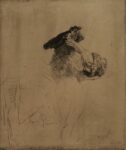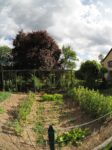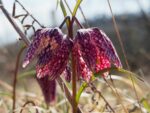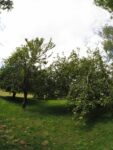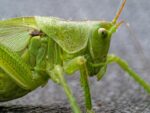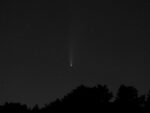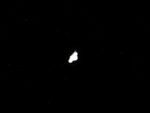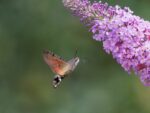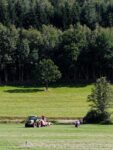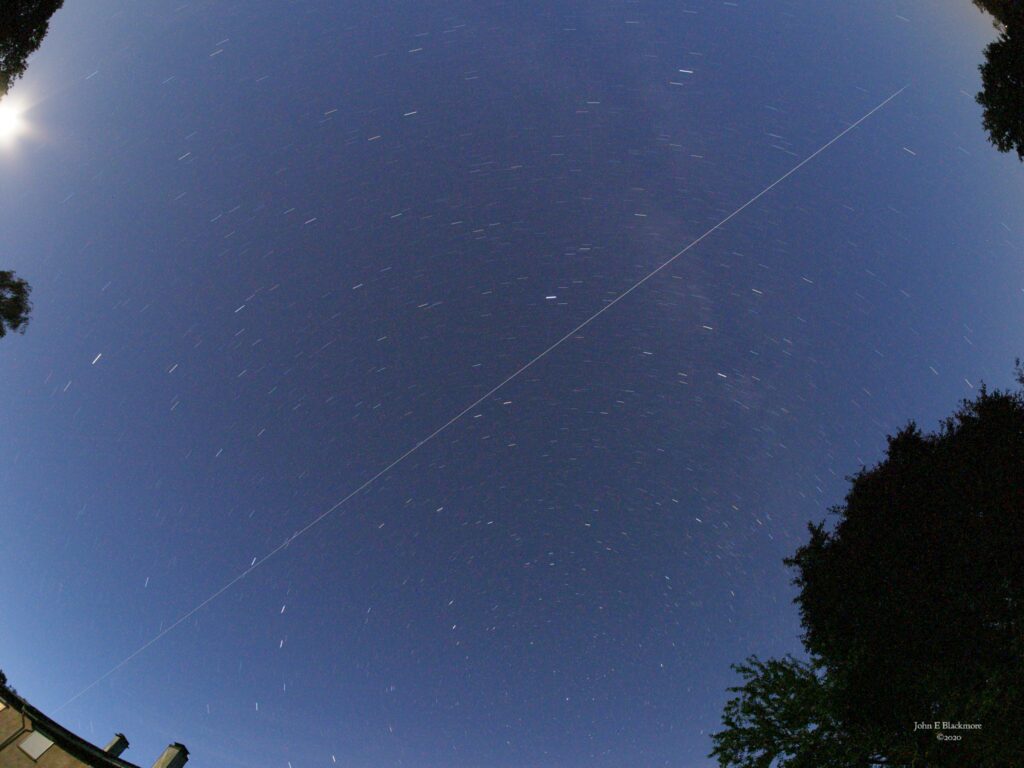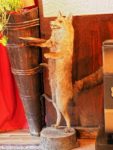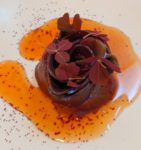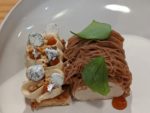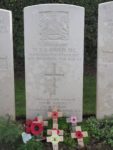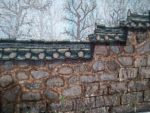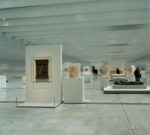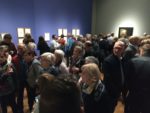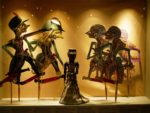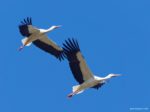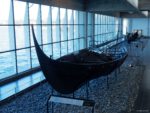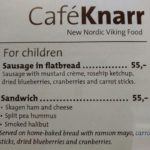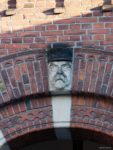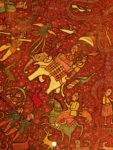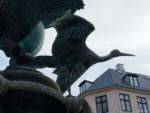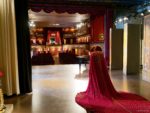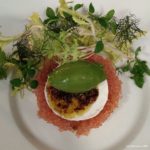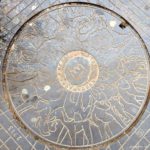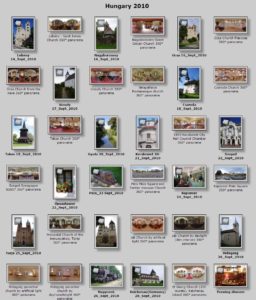To download a printable PDF version (no pictures)
click on this link E2E2020no2.pdf (seven A4 pages)
Clicking on the photographs in the text will usually lead to
a larger selection of photographs or a panorama;
there are links to more at the end
We have been reminded that there has been no newsletter since the end of January, but, as you can imagine, that is only because there has been no news apart from the universal Covid-19 and little of everyday interest to share. But for anyone with time on their hands, here are a few scenes from over the Channel.
The February fill-dyke, behaved to form with heavy rain, high winds and power cuts. Shortly before we left for February half-term in the UK, the rain water was dangerously close to overflowing the ditch on the opposite side of the road which had led, a couple of years ago, to our barn flooding with muddy water while we were away. Fortunately this time the mayor took our phone call seriously and after a wild, windy, wet night the two commune employees arrived with a huge digger and a truck for carting away the mud and dead leaves. Perhaps the forthcoming local elections had something to do with the speed of response! However since then Mayor Duhaut has obviously been alerted to the fact that as the Brits are no longer European citizens, we have lost our vote in local and regional elections. (In fact, having left the UK over fifteen years ago, we have no vote anywhere for anything now, which feels irresponsible). Storms were then forecast over northern France for the Channel crossing we had booked, so we loaded the car set out, stayed the night an hour from Calais, and caught an earlier boat. We were glad we’d made the early crossing when the staff started putting out piles of sick bags ready for the anticipated rough crossings later in the day!
We enjoyed our couple of weeks in Letchworth and catching up with the family. At the time it felt as if we did not do a lot, given the poor weather, but with hindsight after the cessation of activity, it was pretty busy! We went on a tour of the Letchworth Archives, which have interesting objects, furniture, documents and plans from the early twentieth century and the founding of the Garden City.
And another day there was an interesting exhibition of, mostly new to us, Rembrandt prints in the neighbouring small market town (lent by the Ashmolean Museum in Oxford), which brought back happy memories of our holiday in Amsterdam in 2019. We also stocked up on books from the excellent Oxfam in Saffron Walden (appreciated in the quiet months ahead) and bought a Lutyens style garden bench in the market (which sadly we haven’t been back to enjoy). We were delighted to have Jessica and Mark staying for a few days, and grateful to spend precious time with Mark before his death in March, and it was good to stay with Ann and Derek on our way back to Dover.
We had very few border checks, although the outside of the car was checked for something, perhaps drugs, at Dover. Back in E2E a few roof tiles had blown off and we woke to snow next morning. Despite a lack of a personal introduction from another villager, we eventually managed to contact a roofer and assistant from Saulcy, with ladders longer than ours, to replace the tiles.
At the end of February John had an appointment in the ORL department of St Dié Hospital. Usually one can just rearrange the letters to the more familiar English ones, but ORL (Oto-Rhino-Laryngologie) does not reform handily to ENT. Many of the hospital consultants in this part of France now seem to be from Romania and other east European countries, and this was no exception. John explained to her that he had initially fared well with the hearing aids he had tried out in the UK before Christmas until one side seemed to keep cutting out. Her examination revealed that he had a perforated drum, which needed to heal before any further action was taken, but meanwhile he had a thorough hearing test.
John was meant to return after a couple of months, but of course that was delayed by Covid. How the hospital had changed by mid July when he finally returned. The registration hall which is normally thronging with patients checking in was almost deserted, apart from staff manning tables by the door to enforce hand gel, the corridors were quiet, and the waiting room had only one other person waiting. A few weeks earlier Madame Laine had reported long, spaced queues outside the main door. The verdict? The ear is healing well. Hearing test slightly better. Come back in six months when the scarring is complete.
February ended stormily on 29th, with rain lashing against the window and the power cutting out at 15h, mid-ironing. At 17h when, according to their web site, EDF had expected have to fixed it, it was still off in a large area around us, and 18.30 restoration was predicted for most places but by 21h for our end of E2E. We boiled up water on the gas for tea, and brought up wood for the stove together with the old church candles we used back in 1999 when the roof blew off and we had several days without electricity and heating. John prepared a stir fry to cook quickly, we pulled down the blinds (as the shutters are electrically operated), opened a good bottle of wine and played patience by candlelight. After just over six hours power returned (and we eventually received 12€ compensation on our next electricity bill).
March was launched with Roger and Dorinda’s surprise arrival to stay in one of the gîtes two doors from their old house on the hill above Anould. So we enjoyed tea and patisseries with them and planned a restaurant trip together. When we heard nothing from them later in the week, after more wind and power cuts, we joked that they must have gone home. And indeed they had got fed up with all the rain and were concerned about the virus in crowded places and had set out for home.
So we decided to brave the outside world and lunch in the book village at L’Imprimerie, just the two of us. We ate at the counter, so watched the second chef fastidiously decorating the amuse bouches while keeping an eye on the cabbage rolls and chicken being cooked over the open fire.
We really enjoyed the unusual food combinations (who would believe that charcoal-coated spheres of liquid eel juice could be so delicious, or the cabbage rolls that included chestnut with sliced truffle and apple puree, not to mention the first dessert of liquorice, beetroot and cream, and the second of saffron mousse).
And the regional wines were quirky, including an interesting cloudy golden Arbois wine made with an ancient white Savignin grape, named Orange was the colour of her dress, after a Charles Mingus song. As a bonus, the sun shone, which always lifts the spirits. The following week, as the threat of Covid increased, we had what we suspected might be our last meal out on Thursday 12 March at another favourite restaurant, Chez Guth, in the Alsace hills.
That very evening, President Macron broadcast to the nation, announcing the closure of schools, crèches and nurseries after the weekend, though the first round of elections could continue on Sunday; people over seventy should stay at home as much as possible, and others should work from home where possible; any closure of international borders would be decided at European level. Two days later restaurants, cinemas, cafes, nightclubs were ordered to close and by day 4 of our self-isolation Macron announced that self-certification travel certificates had to be downloaded and filled in. They allowed only a few specific reasons for a local-only journey and time of leaving home had to be stated, or fines would be issued. Schengen borders would close. Plenty of decisive clarity here as opposed to the UK.
As if to compensate for home confinement, a lovely period of sunshine followed Macron’s announcement, so it was a pleasure to risk an early start to the year’s gardening. John constructed a cold frame from old bricks and windows in which we sowed lettuce, rocket and radishes. We ate the last of the curly kale, rotavated the potager and raked and marked out beds, and remembered to pick the young ramson or wild garlic leaves from a neglected corner when we wanted a garlic flavouring. Rhubarb was planted, herb beds trimmed and weeded, and fruit bushes pruned and fed with fertiliser. The vegetable plot borders our quiet dead-end road. On sunny days it felt as if half the village had decided to stroll or bike along the quiet road (probably without a downloaded certificate) to the cowsheds at the end and to stop for an animated chat as they passed each other at a safe distance. It was a good thing we had stocked up on cheap seeds during our February break in Letchworth, and could sow cheerful marigolds, candytuft and cornflowers in the tubs at the front of the house, cress indoors on windowsills, and broad beans and onions in the small, sunny potting area at the back of one of the barns. But the cold nights and the sight of fluffy snow flakes drifting past the windows like the white damson blossom behind delayed any outside vegetable sowing.
By 1 April Covid deaths in France had risen to 4,000. Paris was, of course, the worst affected, but our region of Grand Est was the next worst, largely due to infections at a very large evangelical conference in Mulhouse in Alsace (close to the airport and the German and Swiss borders) held before the dangers were realised. The Mulhouse hospital was soon full and patients were moved up to Colmar hospital and later to other hospitals across France, and the army constructed the first field hospital.
There had been TV scenes of police patrols issuing fines to walkers in mountain areas and of night time curfews in different areas. Not surprisingly we did not see any police cars out this way! We were impressed that the Mayor’s deputy rang to check that we were all right, could get out to shop and had the necessary documents to do so. The advantage of a small community! The dustbin men were uncomplaining about the twelve bags of recycling after we started weeding our filing cabinets. Expecting a possible lockdown we’d laid by enough food for a month without the need to visit a shop. Although we had been well stocked with food throughout March we really wanted some fresh fruit and vegetables. John experimented with Cora’s click-and-collect site which served us well throughout the confinement not only with food but with items like an ironing board cover, salad spinner and more broad bean seeds. Initially there seemed to be no collection times shown; in fact they’d all been taken very quickly. And it was only by constant monitoring John discovered when the rolling schedule for the three days was released.
We are fortunate in being surrounded by fields to walk in as well as the garden and orchard. By April the daffodils and cowslips were coming to an end and there were fritillaries in one field. On Easter Sunday when Helen looked out of the window the mother of the two children in the chalet beyond us was scuttling round their garden presumably hiding their Easter eggs.
When the confinement was extended into May, the Mayor came round delivering more yellow recycling bags. We were horrified to hear that Claudine from the big house at the far end of our road had been very ill with the Coronavirus (especially as she had, shortly before lockdown, given Helen the traditional French greeting of a kiss on each cheek). The Mayor obviously anticipated us being out and about a bit more after May 11th, as towards the end of April we found four face-masks in our letterbox from the Mairie and a note thanking the volunteers who had made them. Two had pink rosebuds on the fabric and two were a sober blue and the packing said 2H, 2F, so rather sexist!
In May the lilies of the valley and honeysuckle were heady with scent, the blowsy crimson peonies, clematis and marguerites added colour to the garden, while the orchids were pretty in the fields and marsh marigolds gleamed in the marshier areas. Then after the glorious weather, when we gardened most days, occasionally sitting down to actually enjoy the garden, we had strong winds and torrential rain which flattened the grass crop in the field on the other side of the road. The temperature obediently dropped on 11, 12 and 13 May, traditionally the days and nights of the French ice saints. So it was too cold to have our coffee and cake on the balcony or outside on Helen’s birthday, but the coffee cake was delicious, and fortunately John did not decorate it with the silly brown bears from a past Christmas cake that he was so pleased to have found in a drawer. As we could not go out to dinner, the chef, by special request, cooked a new (to us) Ottolenghi chicken recipe. There had indeed been the forecast easing of restrictions on 11th May in much of France, but as we were in a red area (still pressure on hospitals) as were Paris, Ile de France and … wait for it … the department of Mayotte (north of Madagascar; any newspaper Coronavirus figures for France includes cases for the S American, Caribbean, and Indian Ocean overseas departments as well as for the hexagon or France in Europe).
However we could now drive up to 100 km as the crow flies within the Département without filling in a form, the wearing of masks was obligatory on public transport and in shops that specified it. Bookshops, libraries, small museums and hairdressers could also re-open, though not restaurants. Our MoT equivalent testing centre promptly re-opened and reminded us that our re-test was overdue. After the test, we celebrated the new freedom with a drive through the very empty streets of St Dié, admiring the large wall paintings. In the last week of May schools also reopened and the gardens round us sounded strangely quiet.
The weather seemed to suit the strawberries, both cultivated and wild which were plentiful this year, though sadly May’s ice saints, including St Pancras, must have attacked the plum blossom, but the other fruit blossoms escaped as we have plentiful apples and pears weighing down the orchard trees at present. The cherries seem to have been plentiful too in more sheltered areas than our ice-pocket valley, as in June the ex-mayor’s companion brought round large trays of cherries from La Soyotte, the traditional farm in Sainte Marguerite which has been preserved as a museum of everyday life. John made four jars of cherry compôte from the ones we bought, and Madame Laine made cherry clafoutis from the ones she bought (which Helen sampled it on one of her visits and was surprised by the potent rum flavour, as Danielle always used to say she did not drink, though seemed to knock back her share at village feasts).
The wildlife has flourished with Helen watching a baby deer careering across our field as she took the washing in, then hearing a loud thump as it bounded across the road and was hit by a car that wouldn’t have seen it emerge from behind the trees. But it seemed unaffected as it bounded up the bank on the other side of the road. Maybe it was the same one John startled two or three months later as he was taking photos very near it (he was equally surprised as it leapt out).
John’s photos of flowers and insects this year have been a pleasure to see. We were amused to see a grasshopper on our front door bell in June, looking as if it wanted to ring it. Less amusing were the huge snails heading purposefully across the tarmac to the new seedlings in the potager.
Finally on June 1st our Grand Est region was declared a green area. This allowed restaurants to re-open, with suitable precautions, like customers wearing masks when walking round the restaurant and staff wearing gloves and charlottes. The charlottes rather puzzled us as we could not imagine the need to wear their desserts or the potatoes, but reference to the dictionary revealed that charlottes are also bonnets, sun hats or plastic or hygiene caps.
Siaskas (fromage de Munster frais), bitter cherries marinaded in cherry kirsch, kirsch cream, meringues
click to see more
When we celebrated at L’Imprimerie one chef was bare-headed and the other had his usual cap, but everyone including the reluctant waiter were in their masks. The owner likes practising his English; we always find his English a bit difficult to follow, but it seems rude to ask for repeats, and a mask didn’t help! But he is always so friendly and likes to know what we think of dishes, especially new ones like the dessert of bitter cherries. The countryside round the book village looked so lush since we were last there three months earlier.
And our second lunch out a week after, back at Chez Guth in mid-June was superb. His starter of cucumber and feta was so tasty and pretty and the trout with shrimp sauce main was different from anything we’ve had there before. The cherry dessert was also delicious. We were glad to hear they they had done well during lockdown, serving up to 100 reasonably priced take-away meals (plus instructions) per day at weekends and were continuing while custom built up. The closure period seemed to have given chefs time for all kinds of creative ideas; we had the most interestingly different meal there that we have had since our first visit.
With large gatherings not permitted, the pensioners activities did not start up again after lockdown was eased, apart from the walking group. The, newly-instituted-last-year Bastille Day village fireworks were cancelled.
But Helen had a slightly longer chat than usual with a couple of younger neighbours who walk past the vegetable patch with their small dog each afternoon at the same time. After all these months of daily greetings, the wife finally ventured, “Excuse me, if it’s not indiscreet, might I ask a personal question?” Permission graciously granted, she continued, “I can’t help noticing that you have an accent. Where are you from?” If only she’d asked her next-door neighbour, Madame Laine. who loves a good gossip, she would have learnt of 30 years of our life histories in no time! But Danielle had her own big news: at the beginning of July she looked round and signed up for a room in a brand new care home in Plainfaing from September. By the end of July, her cases were packed and ready for her new life. We hope she likes it once there, as she is clearly expecting to find lively company and conversation with other residents as well as constant care.
In mid-July John was to be found wandering round in the middle of the night with his camera, trying to find the best spot from which to get a good view of the Neowise comet. One unsuccessful early morning at 4am he drove up the hill towards Fouchifol, where he found another man packing up his equipment, who hesitantly asked if he was the Englishman. John vaguely recognised though could but place him. The man said he should have come a bit earlier before it became too light, and showed him his pictures. As we chatted next morning, we worked out that he was a well-known local photographer of wildlife. Although we occasionally see them at village functions, our main conversations in the past have been outside a museum in Colmar and with his wife at a genealogy exhibition in St Dié – and now on the deserted dark road to Fouchifol.
Later in July and August as well as the fauna and flora, with clear night skies he got interested in trying to photograph the International Space Station (ISS), Jupiter and its moons, Perseids meteor showers and the Milky Way (although long exposure shots were marred by satellites and the inevitable planes).
We decided that we should try out a few unfamiliar restaurants in July. These included La Grange, which the older chef at the Ducs de Lorraine elegant restaurant in Epinal had set up with his new partner in a small village, after retiring from the Ducs and divorcing his annoying, bossy, wife. Apparently they are aiming at a warm and welcoming atmosphere and good reasonable food. That seems to involve not wearing masks or other protection and not bothering too much about hand sanitiser or social distancing. His food was nothing like as good as it used to be. The walls were adorned with pink and lime green plastic fly swats which a man at an adjacent table was using with relish (and success) on the flies on his table. A cat was sitting on another table. We were not convinced by “warm” and “welcoming”.
The big excitement when we tried out Quai 21 in Colmar was that John forgot his mask, so we had to stop on the way to buy one from a pharmacy. But of course you can’t go into a pharmacy if you are not wearing a mask, and he refused to wear Helen’s rosebud one. The white ones Helen bought were lighter and less stifling to wear, so it was not a disaster. With school holidays having started everywhere and travel permitted, the cars on the main road over the pass to Colmar were mainly German and Belgian, and Colmar was packed with tourists, so not as pleasant to walk by the picturesque canals as out of season. Lunch in the quayside restaurant was carefully cooked and presented, but no exciting flavours and combinations to tempt us back.
August has been quieter. Helen had got a lot of bites (despite being smothered in repellent) in July while gardening and fruit picking and they had become infected, so she was itchy, scabby and oozing. After consultations with the GP (and linguistic discussion of the words for scab) and a dermatologist (also Romanian), she emerged for the pharmacy with a large bag of antibiotic pills, sprays, gel and cream, and after two weeks is beginning to look slightly less blotchy. Meanwhile John pulled his back, and had to cancel his physiotherapy for Achilles tendinitis. So we have been a couple of old crocks and the neglected garden has become overgrown,
Nevertheless, we are working our way through beans, courgettes and raspberries and John has taken some beautiful pictures of butterflies and moths (including the fascinating humming bird hawk moths).
But there was also some human interest to be spotted in the fields around us. Last Saturday afternoon a tractor and trailer turned off the main road across the valley into the village and came to a halt in the field, which had been cut and baled by the young farmer from Taintrux.
As figures in white and black descended and posed, we realised, with the help of binoculars, that the small wedding party having photos taken in front of the tractor and trailer were the young farmer, his bride, bridesmaid and several page boys. They must have been en route from the ceremony to the reception, as various cars passed, hooting. Were they about to celebrate in the E2E village hall now that gatherings of up to thirty people are permitted (though numbers in the Mairie are restricted and social distancing, masks and hand gel compulsory there and in church). At least the wedding party did not head up our road to the large cattle shed for more photos and festivities.
So every day life continues in Entre-deux-Eaux and, as travel restrictions threaten, we are likely to remain quietly here for much of the remainder of the year. Meanwhile we send you all our greetings and hope for a time when we can meet again.
Some other panoramas around the farmhouse taken in early July
(I should have cut the grass first!)
West end field
Garden swing and west garden
Farmhouse from septic tank filter cover
E2E potager (veg patch)
Over the potager fence and two people walking along the road
The bottom field which has gone wild
Orchard
Arboretum


